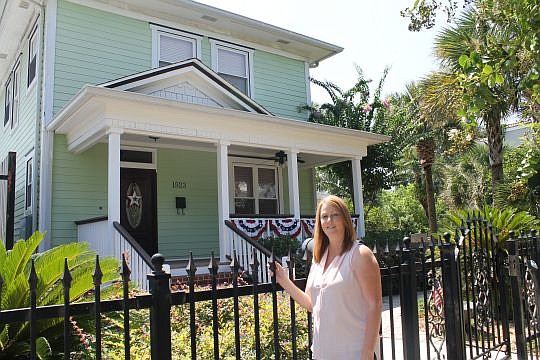
Amanda Searle as a high school student would hang out with her friends in Tampa’s Ybor City neighborhood before it was redeveloped.
Being the daughter of Tampa’s city planner would give her a bird’s-eye view of its eventual transformation — from a district filled with old Cuban cigar factories, bars and restaurants into a tourist destination.
Today, a Springfield resident and Realtor who specializes in historic properties, Searle is inspired by the same kind of transformation happening in Jacksonville.
“I like seeing development breathe life into old communities,” she said. “I don’t think I could be in real estate if I only sold homes in new communities.”
The definition of “historic” can be elusive, though.
As she showed a renovated two-story Victorian at 1923 Market St., she pointed out its full front porch, a characteristic of the Springfield neighborhood. Not so characteristic, perhaps, was its backyard Zen garden, built-in pool and spa.
“Every house is rebuilt during the course of its lifetime,” she explained. Historic means there are defining features from the original period that remain.
Residents who buy in Springfield want the large base molding, crown molding, inlaid wood flooring and a full-length front porch, Searle said. The Market Street home offered these with a bonus — original built-in cabinets.
At the same time, many residents want their historic homes updated for modern use.
So at 1923 Market St., there also are drop lights and a new kitchen, with oak cabinets and tile countertops. It offers an open floor plan — due to the demolition of a wall separating the kitchen and dining room and the widening of a doorway between the kitchen and living room.
If it sells for the list price, $280,000, it could be the top sale in Springfield, said Searle, an agent with Magnolia Properties.
When it comes to historic homes, Jacksonville’s three major districts offer a range of options, Searle said.
Springfield, built mainly between 1900-30, has Queen Anne-style homes, with flowing staircases leading to upper floors.
Riverside and Avondale, built later, features Arts and Crafts, bungalow-style homes.
San Marco offers a Mediterranean Arts and Crafts-style, as well as a 1940s brick ranch-style.
Looking for a historic home will mean one of two things, Searle said — shopping for a fully renovated home like 1923 Market St., or looking at rehabs and sometimes even completely gutted houses.
Searle helps with both kinds of sales.
She earned her college degree in art history and studied architecture and urban planning in grad school.
After a stint as a flight attendant, she and her husband moved to Jacksonville. A friend from Tampa had told Searle about Springfield.
“It reminded me of Ybor City,” she said.
At first, Searle wanted to be an appraiser. But, after she passed the state’s appraisal exam, a friend suggested she get her real estate license to become more familiar with the Jacksonville market.
The career stuck.
“I had expected it to be a sales job,” Searle said. “But it’s more of an entrepreneurial, run-your-own-business kind of a job.”
Studying appraisals helped her to price homes and their repairs.
On renovated homes, Searle looks to make sure the job was done right. On rehabs, she helps connect clients with inspectors, contractors, insurance agents and lenders who specialize in historic projects.
“Some contractors think you can just go in and rip everything out and that’s not necessarily true. Some think you can insulate all the walls and that’s not necessarily true,” she said.
A good inspector can explain issues to buyers without upsetting them over trivial problems.
Over Searle’s 11 years in real estate she’s confronted knob-andtube wiring, structural damage from termites, even a home that that was twisted from a foundation “repair.”
Most everything is fixable, even structural problems. The key is to make sure the cost is reflected in the offer price. The average full-home rehab easily costs $120,000 to $140,000, she said.
Searle has experienced what her clients go through. She and her husband rehabbed their own home in Springfield. Then, they bought another.
It was a foreclosure that Searle just couldn’t pass up.
“It was my crazy idea to buy it,” she said. “I talked to my husband about it. I had to do my selling.”
Originally built for the vice president of Duval Planing Mill Co., the home was finished with burled pine wood. It had original plaster and four fireplaces.
It was a rehab, though. The couple had to tear out knob-and-tube wiring and galvanized piping and replace the roof and air conditioning.
Historic rehabs demand a lot of problem-solving. But that’s what Searle likes about it. “Every house has a different character. It’s never boring,” she said. “No two old houses are the same.”
(904) 356-2466